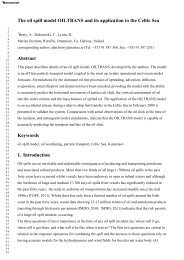Marine Industries Global Market Analysis - Marine Institute
Marine Industries Global Market Analysis - Marine Institute
Marine Industries Global Market Analysis - Marine Institute
You also want an ePaper? Increase the reach of your titles
YUMPU automatically turns print PDFs into web optimized ePapers that Google loves.
MARINE INDUSTRIES GLOBAL MARKET ANALYSIS<br />
53<br />
double its GDP every ten years and this is likely to continue for the foreseeable<br />
future. However, the recent economic boom could return to its long-term trend with<br />
8% forecast in 2005 compared with an estimated 9.3% in 2004. 25 (It should be noted<br />
that unofficial estimates have put China’s GDP growth at 11% in 2004.)<br />
Figure 6.5: Danish Shipowners Earnings 2003<br />
The growth rate of capital asset investment is expected to be 27% in 2004, (a drop of<br />
15% from the first quarter) and 24% in 2005.The Chinese government has stated that<br />
cooling the economy will be a priority in 2005 and rising interest rates and<br />
government-imposed lending curbs are reported to be initiated.<br />
Economic activity has exceeded long-term rates as large amounts are imported to<br />
both feed manufacturing and infrastructure developments.The overall result is an<br />
unprecedented increase in two-way traffic – import of bulk commodities and export<br />
of containers of manufactured goods.<br />
Source: Danish Shipping – Figures 24<br />
Further Chinese growth is also likely as the European global quota system on textiles<br />
and clothing is lifted. Ultimately there must be a limit as high growth rates become<br />
harder to maintain. For example, China already has 80% share of US imports of toys<br />
and footwear.<br />
6.4 EUROPEAN MARKET<br />
Within Europe the market was estimated to be worth €151 billion in 2004.The<br />
European Union is very dependant on maritime transport. Official statistics state that<br />
70% of external trade (the European Community Shipowners Association say 90%)<br />
and 20% of internal trade in terms of volume is made by sea. A large part of the<br />
increase over the years can be attributed to the import of oil and oil-based products.<br />
Shipping divides into two areas; deep-sea transport – shipping on long sea routes, and<br />
short-sea shipping – between national or European ports.<br />
It has been stated that there were 14,000 enterprises active in the EU in 2001<br />
generating €13.4 billion of added value and employing 155,000 persons. (Includes<br />
both deep-sea and coastal transport.) The value added at 232% of personnel costs<br />
compares with an average (for non-financial services) of 148%.<br />
The sector is characterised by ‘flags of convenience’ or ‘open registries’ whereby<br />
vessels controlled by owners in one country are registered in another that offers more<br />
attractive terms for taxation and legislation.<br />
24<br />
‘Danish Shipping – Figures’ Danish Shipowners Association. 2004.<br />
25<br />
‘Survey by the China National Bureau of Statistics’ reported in China Daily, 20 December 2004.

















